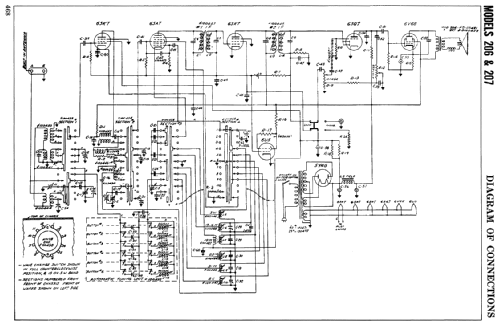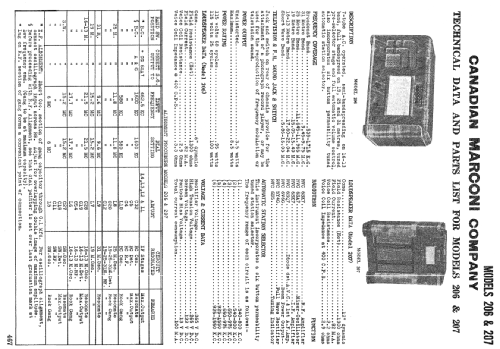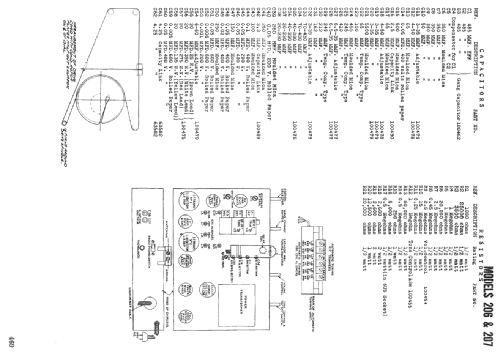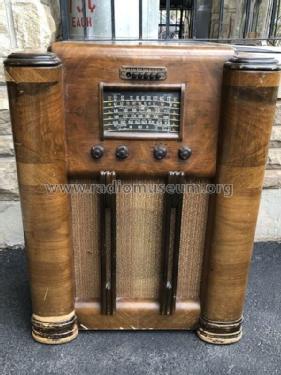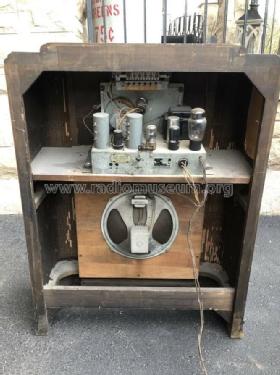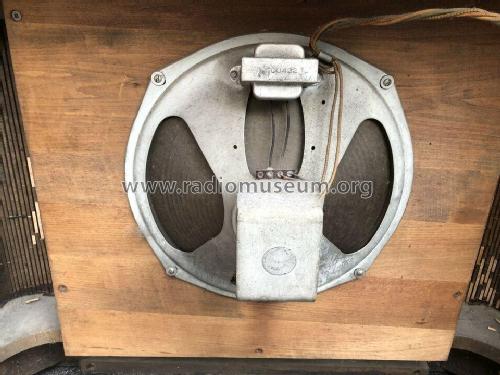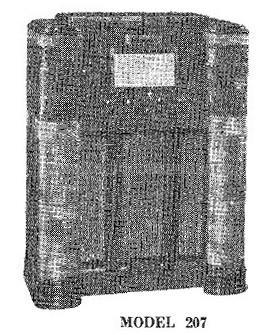- Pays
- Canada
- Fabricant / Marque
- Canadian Marconi Co. Ltd. (CMC, Esterline), Marconi's Wireless; Montreal, QC
- Année
- 1941 ?
- Catégorie
- Radio - ou tuner d'après la guerre 1939-45
- Radiomuseum.org ID
- 299007
-
- alternative name: CMC Canada || Marconi, Canada
Cliquez sur la vignette du schéma pour le demander en tant que document gratuit.
- No. de tubes
- 7
- Principe général
- Super hétérodyne avec étage HF; FI/IF 462.5 kHz; 2 Etage(s) BF
- Circuits accordés
- 7 Circuits MA (AM)
- Gammes d'ondes
- PO et plus que 2 x OC
- Tension / type courant
- Alimentation Courant Alternatif (CA) / 115 Volt
- Haut-parleur
- HP dynamique à électro-aimant (électrodynamique) / Ø 12 inch = 30.5 cm
- Puissance de sortie
- 3.5 W (8.5 W max.)
- Matière
- Boitier en bois
- De Radiomuseum.org
- Modèle: 207 - Canadian Marconi Co. Ltd. CMC,
- Forme
- Console avec des boutons-poussoirs
- Remarques
-
The Canadian Marconi model 206 is a 7-tube console radio with tuning eye tube and pushbutton station selector. Covers the following ranges:
Band Frequency (kHz) Standard Broadcast 540 - 1710 Shortwave 5860-16030 31m 9450 - 9750 25m 11645 - 11965 19m 15050 - 15400 Shortwave 17600 - 22040
- Schémathèque (1)
- Marconi Service Manual (Volume 1) (P. 467-470)
- Auteur
- Modèle crée par Tom Seeger. Voir les propositions de modification pour les contributeurs supplémentaires.
- D'autres Modèles
-
Vous pourrez trouver sous ce lien 462 modèles d'appareils, 325 avec des images et 378 avec des schémas.
Tous les appareils de Canadian Marconi Co. Ltd. (CMC, Esterline), Marconi's Wireless; Montreal, QC
Contributions du forum pour ce modèle: Canadian Marconi Co.: 207
Discussions: 1 | Publications: 2
This is my first renovation, and my first post, so I'm a bit reticent in case I have my finding wrong. But I don't think so!
This is the Marocni 207, electrically identical, I believe, to the 206, and I'm looking at R18 / R19 in parallel, which feed voltage to the screen grids of the first & second stages of the RF path. The components list shows these as 2K6, 2W each, to give a combined value of 1K3 at 4W.
In my restoration of serial no. 4511, the parallel pair shows 40K instead of the advertised 1K3. That's a clue! But the resistors themselves have colour coding for 26K, not 2K6. Looking at the specs for these two valves (sorry, I can't get used to calling them "tubes," even though I now live in Canada), it's clear that a value of 1K3 for the resistor pair just doesn't work. 13K is better.
So I'm postulagting that the components list has the values wrong. Does that make sense? If I get agreement, I'll re-post this as information.
I'm finding that antique radio restoration is a combination of detective work, logic, and hard-earned knowledge. I love it!
Alistair Thomson, 25.Nov.18
